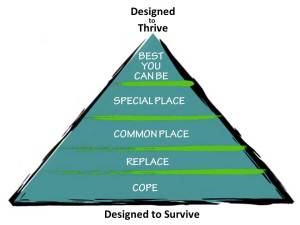Archive for the ‘Uncategorized’ Category
Detroit is much more than a Motor City with mechanical problems.
One of the bad habits that lingers from the industrial age is a tendency to view organic situations as mechanical problems.
The City of Detroit’s financial condition cannot be dramatically improved by using a mechanical approach to problem solving. Mechanical approaches work for fixing broken machines or solving simple problems, but Detroit is neither a machine nor simple.
Detroit is an organic, living being composed of human relationships, skills and capabilities. Many of the city’s resources and assets are currently under-appreciated. An important step in Detroit’s revival is for more people to identify, see the value of, and mobilize her strengths (tangible and intangible).
Just a few of these strengths include the extraordinary community relationships and knowledge that have been developed in order to cope with cutbacks in city services, a culture of making things, a history of innovation and the unpretentious character of Detroiters who have a low tolerance for phonies.
Focus on strengths, not needs
Most people see Detroit in terms of needs. When you think only about needs, it’s easy to feel overwhelmed. So it’s time to make a conscious effort to see beyond needs and pay more attention to strengths. This approach isn’t just about being positive or negative; it’s about making the most of natural assets (human and physical) that can be further developed.
Difficulties to be “outgrown,” not “fixed”
Mechanical approaches to problem-solving begin by identifying, then fixing problems and deficiencies. But since Detroit is not a problem to be fixed, it must outgrow the extreme conditions which held it back in the past. For example, the mutually destructive relationship that people in the suburbs have had with people in the city of Detroit is most likely to change through the mega-shift to cities now happening everywhere.
Many young people no longer want to work in anonymous, dismal “office parks” and live in isolated suburban neighborhoods. Older people want to “age in place,” which means being able to walk to see friends and get groceries. When sons and daughters move to the city of Detroit, a suburban parent is more likely to support funds for public safety and other services.
This process of change can be described as organically outgrowing a bad situation, rather than mechanically solving a problem. To speed up this natural growth process, it is crucial to shine a light on assets, which is what we tried to do in a fun way by creating our song “What I See in the D” http://goo.gl/du25PA
Our song is about what’s strong that will help Detroit outgrow what’s wrong. And it’s about really good reasons to move to the D.
– Sharon VanderKaay
Overlooking a city that has received unwelcome international attention lately, the “Man in the City” sculpture project consists of 30 identical orange metal figures located on rooftops throughout Detroit.
As many observers have pointed out, the city of Detroit may be bankrupt but the people are full of talent and can-do spirit. John Sauve, a Detroit native, has exhibited his strikingly simple figures in several locations, including on New York City’s Governors Island. These 43” sculptures change the skyline, cause people to look up, and reward the urban explorer with each discovery.
The artist has also created the Sauvé Art Foundation, which brings a children’s educational dimension to the project. According to Sauve, it “…activates the skyline, and encourages people to look around. In this process of looking and finding, one re-assesses one’s own position in the world and becomes aware of one’s scale…(as well as reflecting on) alienation, ambition, anonymity and fame.”
The figures seem to be watching over a city that is in the process of finding new ways to work through old problems. In my imagination, these orange men see better things on the horizon.
Here is a set of photos I took around the city of Detroit last week.
– Sharon VanderKaay
How do we talk with decision makers and other citizens about being the best they can be?
How can we help them see opportunties to realize their full potential by inventing new categories; by bringing people together in new ways?
The diagram above was inspired by Abraham Maslow’s concept of self actualization by understanding of a hierarchy of needs.
In cities like my home town of Detroit, people are becoming aware that they have new options beyond building replacement projects.
-Sharon VanderKaay


